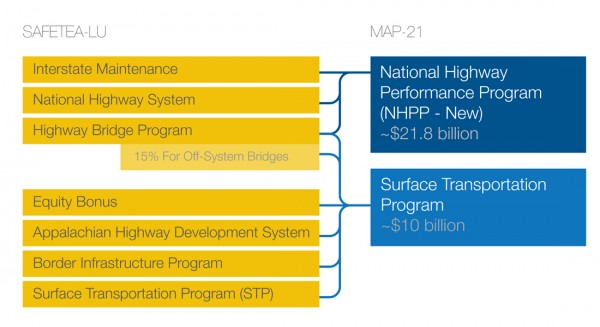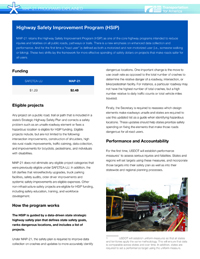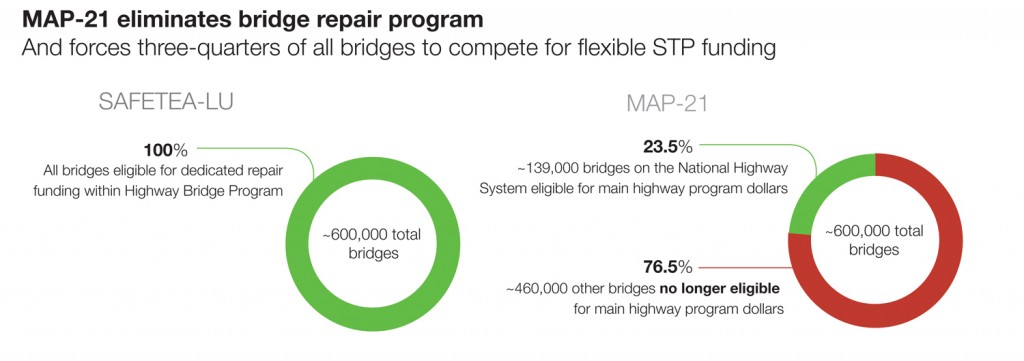The Surface Transportation Program
The Surface Transportation Program is the most flexible of all the highway programs and historically one of the largest single programs. States and metropolitan regions may use these funds for highway, bridge, transit (including intercity bus terminals), and pedestrian and bicycle infrastructure projects. Under MAP-21, new responsibilities were added to the program though funding was not increased proportionally. About $5 billion in new responsibilities were added to the STP, but the program was only increased by $1 billion.
Each year, states must suballocate a portion of STP funds to metropolitan areas over 200,000 in population. This provides regional leaders the opportunity to direct these funds toward local priority projects. Under MAP-21, metro regions will receive approximately the same level of suballocated STP funds as before.
Funding
SAFETEA-LU: $8.8 billion
MAP-21: $10 billion
STP can cover 80 percent of the total cost of a project, with the rest covered by states or localities. States must dedicate an amount equal to 15 percent of their FY2009 Highway Bridge Program apportionment out of the STP program to fix off-system bridges (i.e., bridges not located on a federal-aid highway). The bridge set-aside totaled $776 million in 2009. This bridge set-aside may not come from the money that states are required to suballocate to metro areas for local priorities.
 Eligible projects
Eligible projects
- Highway and bridge construction and rehabilitation
- De-icing of bridges and tunnels
- Federal-aid bridge repair
- Congestion pricing and travel demand management
- Off-system bridge repair
- Development of state asset management plan
- Transit capital projects
- Carpool projects and fringe and corridor parking
- Bicycle, pedestrian, and recreational trails
- Electric and natural gas vehicle infrastructure
- Construction of ferry boats and terminals
- Intelligent transportation systems
- Environmental mitigation
- Border infrastructure projects
How the program works
Under MAP-21, STP continues to provide flexible funding to states and metro regions to implement local and state priorities. Metropolitan regions over 200,000 in population will continue to receive a portion of these funds to direct toward local priorities. Though the share that has to be given directly to metro areas decreases from 62.5 to 50 percent of the program, because the STP grew in size, the overall dollar amount that metro regions receive will remain consistent.
The big difference relates to addressing structurally deficient bridges: For the first time, the STP is responsible for the 460,000 federal-aid bridges not located on the National Highway System. Previously, any structurally deficient bridge could be fixed with funds from the Highway Bridge program, which was eliminated under MAP-21 with virtually all of the money rolled into the new National Highway Performance Program (NHPP).
The problem with this structure is that NHPP dollars can only be spent on the 23 percent of federal-aid bridges located on the National Highway System, ignoring the needs of the over 460,000 bridges not on the NHS.
Thus, the NHPP received all the money for repairing bridges while STP received the responsibility for fixing more than 123,000 structurally deficient bridges not on the National Highway System.
The new responsibility to repair non-NHS bridges is estimated to cost approximately $5 billion. However, STP funding only increased by $1.2 billion. The new burden to repair and rehabilitate deficient bridges will likely make it harder to use STP dollars to fund local priorities — forcing them to compete with the needs of deficient bridges.







